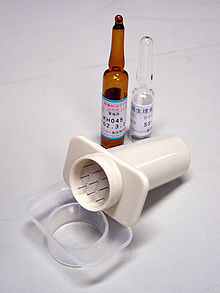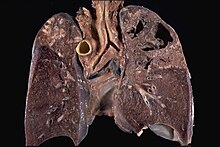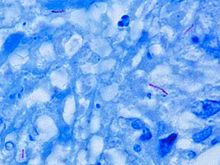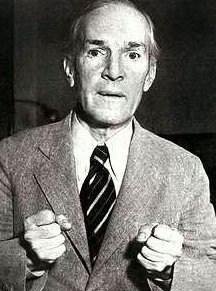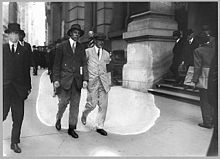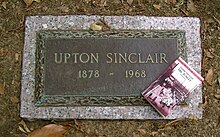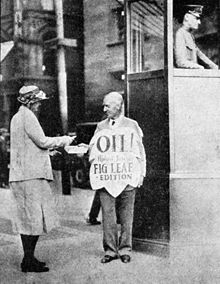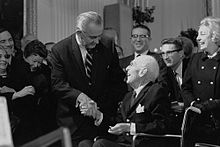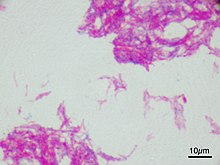
Microscopic image of the Calmette-Guérin bacillus, Ziehl–Neelsen stain, magnification:1,000nn
| |
| Vaccine description | |
|---|---|
| Target disease | Tuberculosis |
| Type | Live bacteria |
| Clinical data | |
| AHFS/Drugs.com | FDA Professional Drug Information |
| Pregnancy category |
|
| Routes of administration | Percutaneous |
| ATC code | |
| Legal status | |
| Legal status |
|
| Identifiers | |
| DrugBank | |
| ChemSpider |
|
Bacillus Calmette–Guérin (BCG) vaccine is a vaccine primarily used against tuberculosis (TB). In countries where tuberculosis or leprosy is common, one dose is recommended in healthy babies as close to the time of birth as possible. In areas where tuberculosis is not common, only children at high risk are typically immunized, while suspected cases of tuberculosis are individually tested for and treated. Adults who do not have tuberculosis and have not been previously immunized but are frequently exposed may be immunized as well. BCG also has some effectiveness against Buruli ulcer infection and other nontuberculous mycobacteria infections. Additionally it is sometimes used as part of the treatment of bladder cancer.
Rates of protection against tuberculosis infection vary widely and protection lasts up to twenty years. Among children it prevents about 20% from getting infected and among those who do get infected it protects half from developing disease. The vaccine is given by injection into the skin. Additional doses are not supported by evidence.
Serious side effects are rare. Often there is redness, swelling, and mild pain at the site of injection. A small ulcer may also form with some scarring after healing. Side effects are more common and potentially more severe in those with poor immune function. It is not safe for use during pregnancy. The vaccine was originally developed from Mycobacterium bovis which is commonly found in cows. While it has been weakened, it is still live.
The BCG vaccine was first used medically in 1921. It is on the World Health Organization's List of Essential Medicines, the safest and most effective medicines needed in a health system. Between 2011 and 2014 the wholesale price was US$0.16 to US$1.11 a dose in the developing world. In the United States it costs US$100 to US$200. As of 2004 the vaccine is given to about 100 million children per year globally.
Medical uses
Tuberculosis
The main use of BCG is for vaccination against tuberculosis. BCG vaccine can be administered after birth intradermally. BCG vaccination can cause a false positive Mantoux test, although a very high-grade reading is usually due to active disease.
The most controversial aspect of BCG is the variable efficacy
found in different clinical trials, which appears to depend on
geography. Trials conducted in the UK have consistently shown a
protective effect of 60 to 80%, but those conducted elsewhere have shown
no protective effect, and efficacy appears to fall the closer one gets
to the equator.
A 1994 systematic review found that BCG reduces the risk of getting TB by about 50%.
There are differences in effectiveness, depending on region, due to
factors such as genetic differences in the populations, changes in
environment, exposure to other bacterial infections, and conditions in
the lab where the vaccine is grown, including genetic differences
between the strains being cultured and the choice of growth medium.
A systematic review and meta analysis conducted in 2014
demonstrated that the BCG vaccine reduced infections by 19–27% and
reduced progression to active TB by 71%. The studies included in this review were limited to those that used interferon gamma release assay.
The duration of protection of BCG is not clearly known. In those
studies showing a protective effect, the data are inconsistent. The MRC
study showed protection waned to 59% after 15 years and to zero after 20
years; however, a study looking at Native Americans immunized in the
1930s found evidence of protection even 60 years after immunization,
with only a slight waning in efficacy.
BCG seems to have its greatest effect in preventing miliary TB
or TB meningitis, so it is still extensively used even in countries
where efficacy against pulmonary tuberculosis is negligible.
Reasons
A
number of possible reasons for the variable efficacy of BCG in different
countries have been proposed. None have been proven, some have been
disproved, and none can explain the lack of efficacy in both low-TB
burden countries (US) and high-TB burden countries (India). The reasons
for variable efficacy have been discussed at length in a World Health Organization (WHO) document on BCG.
- Genetic variation in BCG strains: Genetic variation in the BCG strains used may explain the variable efficacy reported in different trials.
- Genetic variation in populations: Differences in genetic make-up of different populations may explain the difference in efficacy. The Birmingham BCG trial was published in 1988. The trial, based in Birmingham, United Kingdom, examined children born to families who originated from the Indian Subcontinent (where vaccine efficacy had previously been shown to be zero). The trial showed a 64% protective effect, which is very similar to the figure derived from other UK trials, thus arguing against the genetic variation hypothesis.
- Interference by nontuberculous mycobacteria: Exposure to environmental mycobacteria (especially M. avium, M. marinum and M. intracellulare) results in a nonspecific immune response against mycobacteria. Administering BCG to someone who already has a nonspecific immune response against mycobacteria does not augment the response already there. BCG will therefore appear not to be efficacious, because that person already has a level of immunity and BCG is not adding to that immunity. This effect is called masking, because the effect of BCG is masked by environmental mycobacteria. Clinical evidence for this effect was found in a series of studies performed in parallel in adolescent school children in the UK and Malawi. In this study, the UK school children had a low baseline cellular immunity to mycobacteria which was increased by BCG; in contrast, the Malawi school children had a high baseline cellular immunity to mycobacteria and this was not significantly increased by BCG. Whether this natural immune response is protective is not known. An alternative explanation is suggested by mouse studies; immunity against mycobacteria stops BCG from replicating and so stops it from producing an immune response. This is called the block hypothesis.
- Interference by concurrent parasitic infection: In another hypothesis, simultaneous infection with parasites changes the immune response to BCG, making it less effective. As Th1 response is required for an effective immune response to tuberculous infection, concurrent infection with various parasites produces a simultaneous Th2 response, which blunts the effect of BCG.
Mycobacteria
BCG has protective effects against some non-tuberculosis mycobacteria.
- Leprosy: BCG has a protective effect against leprosy in the range of 20 to 80%.
- Buruli ulcer: BCG may protect against or delay the onset of Buruli ulcer.
Cancer
Micrograph showing granulomatous inflammation of bladder neck tissue due to Bacillus Calmette-Guérin used to treat bladder cancer, H&E stain
BCG has been one of the most successful immunotherapies. BCG vaccine has been the "standard of care for patients with bladder cancer (NMIBC)" since 1977.
By 2014 there were more than eight different considered biosimilar
agents or strains used for the treatment of non–muscle-invasive bladder
cancer (NMIBC).
- A number of cancer vaccines use BCG as an additive to provide an initial stimulation of the person's immune systems.
- BCG is used in the treatment of superficial forms of bladder cancer. Since the late 1970s, evidence has become available that instillation of BCG into the bladder is an effective form of immunotherapy in this disease. While the mechanism is unclear, it appears a local immune reaction is mounted against the tumor. Immunotherapy with BCG prevents recurrence in up to 67% of cases of superficial bladder cancer.
- BCG has been evaluated in a number of studies as a therapy for colorectal cancer. The US biotech company Vaccinogen is evaluating BCG as an adjuvant to autologous tumour cells used as a cancer vaccine in stage II colon cancer.
Method of administration
An apparatus (4–5 cm length, with 9 short needles) used for BCG vaccination in Japan, shown with ampules of BCG and saline
Except in neonates, a tuberculin skin test
should always be done before administering BCG. A reactive tuberculin
skin test is a contraindication to BCG. Someone with a positive
tuberculin reaction is not given BCG, because the risk of severe local
inflammation and scarring is high, not because of the common
misconception that tuberculin reactors "are already immune" and
therefore do not need BCG. People found to have reactive tuberculin
skin tests should be screened for active tuberculosis. BCG is also
contraindicated in certain people who have IL-12 receptor pathway
defects.
BCG is given as a single intradermal injection at the insertion of the deltoid. If BCG is accidentally given subcutaneously,
then a local abscess may form (a "BCG-oma") that can sometimes
ulcerate, and may require treatment with antibiotics immediately,
otherwise without treatment it could spread the infection causing severe
damage to vital organs. An abscess is not always associated with
incorrect administration, and it is one of the more common complications
that can occur with the vaccination. Numerous medical studies on
treatment of these abscesses with antibiotics have been done with
varying results, but the consensus is once pus is aspirated and
analysed, provided no unusual bacilli are present, the abscess will
generally heal on its own in a matter of weeks.
The characteristic raised scar that BCG immunization leaves is
often used as proof of prior immunization. This scar must be
distinguished from that of smallpox vaccination, which it may resemble.
Adverse effects
BCG immunization generally causes some pain and scarring at the site of injection. The main adverse effects are keloids—large,
raised scars. The insertion of deltoid is most frequently used because
the local complication rate is smallest when that site is used.
Nonetheless, the buttock is an alternative site of administration
because it provides better cosmetic outcomes.
BCG vaccine should be given intradermally. If given
subcutaneously, it may induce local infection and spread to the regional
lymph nodes, causing either suppurative and nonsuppurative
lymphadenitis. Conservative management is usually adequate for
nonsuppurative lymphadenitis. If suppuration occurs, it may need needle
aspiration. For nonresolving suppuration, surgical excision may be
required. Evidence for the treatment of these complications is scarce.
Uncommonly, breast and gluteal abscesses can occur due to
haematogenous and lymphangiomatous spread. Regional bone infection (BCG
osteomyelitis or osteitis) and disseminated BCG infection are rare
complications of BCG vaccination, but potentially life-threatening.
Systemic antituberculous therapy may be helpful in severe complications.
If BCG is accidentally given to an immunocompromised patient (e.g., an infant with SCID),
it can cause disseminated or life-threatening infection. The
documented incidence of this happening is less than one per million
immunizations given. In 2007, The World Health Organization (WHO) stopped recommending BCG for infants with HIV, even if there is a high risk of exposure to TB, because of the risk of disseminated BCG infection (which is approximately 400 per 100,000 in that higher risk context).
Usage
The age of the person and the frequency with which BCG is given has always varied from country to country.
- WHO BCG policy: The World Health Organization (WHO) recommends BCG be given to all children born in countries with a high incidence of TB and/or high leprosy burden.
- Brazil: Brazil introduced universal BCG immunization in 1967–1968, and the practice continues until now. According to Brazilian law, BCG is given again to professionals of the health sector and to people close to patients with tuberculosis or leprosy.
- Central and South America: Most countries in Central and South America have universal BCG immunizations. In Ecuador, a child cannot receive their birth certificate without having the BCG vaccine in their medical record along with other vaccinations.
- France: The BCG was mandatory for school children between 1950 and 2007, and for healthcare professionals between 1947 and 2010. Vaccination is still available for French healthcare professionals and social workers but is now decided on a case by case basis.
- Hong Kong: BCG is given to all newborns.
- India and Pakistan: India and Pakistan introduced BCG mass immunization in 1948, the first countries outside Europe to do so.
- Japan: In Japan, BCG is administered between five and eight months after birth, and no later than a child's first birthday. BCG was administered no later than the fourth birthday until 2005, and no later than six months from birth from 2005 to 2012; the schedule was changed in 2012 due to reports of osteitis side effects from vaccinations at 3–4 months. Some municipalities recommend an earlier immunization schedule.
- Mongolia: All newborns are vaccinated with BCG. Previously, the vaccine was also given at ages 8 and 15, although this is no longer common practice.
- Norway: In Norway the BCG vaccine was mandatory from 1947 to 1995. It is still available and recommended for high-risk groups.
- Philippines: BCG vaccine started in the Philippines in 1979 with the Expanded Program on Immunization
- South Africa: In South Africa, the BCG Vaccine is given routinely at birth, to all newborns, except those with clinically symptomatic AIDS. The vaccination site in the right shoulder.
- Sri Lanka: In Sri Lanka, The National Policy of Sri Lanka is to give BCG vaccination to all newborn babies immediately after birth. BCG vaccination is carried out under the Expanded Programme of Immunisation (EPI).
- Thailand: In Thailand, the BCG Vaccine is given routinely at birth.
- United Kingdom: The UK introduced universal BCG immunization in 1953, and until July 2005, the UK policy was to immunize all school children between 10 and 14 years of age, and all neonates born into high-risk groups. The injection was given only once during an individual's lifetime (as there is no evidence of additional protection from more than one vaccination). BCG was also given to protect people who had been exposed to tuberculosis. The peak of tuberculosis incidence is in adolescence and early adulthood, and the MRC trial showed efficacy lasted a maximum of 15 years. Routine immunization with BCG for all school children was scrapped in July 2005 because of falling cost-effectiveness: whereas in 1953, 94 children would have to be immunized to prevent one case of TB, by 1988, the annual incidence of TB in the UK had fallen so much, 12,000 children would have to be immunized to prevent one case of TB. The vaccine is still given to certain healthcare professionals, however.
- United States: The US has never used mass immunization of BCG, relying instead on the detection and treatment of latent tuberculosis.
- Other countries: In some countries, such as the former Soviet Union, BCG was given regularly throughout life. In South Korea, Singapore, Taiwan and Malaysia, BCG was given at birth and again at age 12. But in Malaysia and Singapore, from 2001, this policy was changed to once only at birth. South Korea also stopped the re-vaccination in 2008. In the Canadian province of Quebec, the BCG vaccine was provided to children until the early 1960s.
Manufacture
BCG is prepared from a strain of the attenuated (virulence-reduced) live bovine tuberculosis bacillus, Mycobacterium bovis,
that has lost its ability to cause disease in humans. Because the
living bacilli evolve to make the best use of available nutrients, they
become less well-adapted to human blood and can no longer induce disease
when introduced into a human host. Still, they are similar enough to
their wild ancestors to provide some degree of immunity against human
tuberculosis. The BCG vaccine can be anywhere from 0 to 80% effective
in preventing tuberculosis for a duration of 15 years; however, its
protective effect appears to vary according to geography and the lab in
which the vaccine strain was grown.
A number of different companies make BCG, sometimes using
different genetic strains of the bacterium. This may result in different
product characteristics. OncoTICE, used for bladder instillation for
bladder cancer, was developed by Organon Laboratories (since acquired by
Schering-Plough, and in turn acquired by Merck & Co.). Pacis BCG, made from the Montréal (Institut Armand-Frappier) strain,
was first marketed by Urocor in about 2002. Urocor was since acquired
by Dianon Systems. Evans Vaccines (a subsidiary of PowderJect
Pharmaceuticals). Statens Serum Institut in Denmark markets BCG vaccine prepared using Danish strain 1331.[52] Japan BCG Laboratory markets its vaccine, based on the Tokyo 172 substrain of Pasteur BCG, in 50 countries worldwide.
According to a UNICEF
report published in December 2015 on BCG vaccine supply security,
global demand increased in 2015 from 123 to 152.2 million doses. In
order to improve security and to [diversify] sources of affordable and
flexible supply," UNICEF awarded seven new manufacturers contracts to
produce BCG. Along with supply availability from existing manufacturers,
and a "new WHO prequalified vaccine" the total supply will be
"sufficient to meet both suppressed 2015 demand carried over to 2016, as
well as total forecast demand through 2016-2018."
BCG supply shortage 2012–2017
In the fall of 2011, the Sanofi Pasteur plant flooded causing problems with mold.
The facility, located in Toronto, Ontario, Canada, produced BCG vaccine
products, made with substrain Connaught, such as a tuberculosis vaccine
ImmuCYST, a BCG Immunotherapeutic – a bladder cancer drug.
By April 2012 the FDA had found dozens of documented problems with
sterility at the plant including mold, nesting birds and rusted
electrical conduits. The resulting closure of the plant for over two years resulting in shortages of bladder cancer and tuberculosis vaccines. On October 29, 2014 Health Canada gave the permission for Sanofi to resume production of BCG.
The global supply situation was analyzed in 2017 and concluded that the
global supply is sufficient to meet forecasted BCG vaccine demand but
risks for shortages remain mainly due to supply concentration.
Preparation
A weakened strain of bovine tuberculosis bacillus, Mycobacterium bovis is specially subcultured in a culture medium, usually Middlebrook 7H9.
Dried
Some BCG vaccines are freeze dried
and become fine powder. Sometimes the powder is sealed with vacuum in a
glass ampoule. Such a glass ampoule has to be opened slowly to prevent
the airflow from blowing out the powder. Then the powder has to be
diluted with saline water before injecting.
History
French poster promoting the BCG vaccine
The history of BCG is tied to that of smallpox. Jean Antoine Villemin first recognized bovine tuberculosis in 1854 and transmitted it, and Robert Koch first distinguished Mycobacterium bovis from Mycobacterium tuberculosis. Following the success of vaccination
in preventing smallpox, established during the 18th century, scientists
thought to find a corollary in tuberculosis by drawing a parallel
between bovine tuberculosis and cowpox:
it was hypothesized that infection with bovine tuberculosis might
protect against infection with human tuberculosis. In the late 19th
century, clinical trials using M. bovis were conducted in Italy with disastrous results, because M. bovis was found to be just as virulent as M. tuberculosis.
Albert Calmette, a French physician and bacteriologist, and his assistant and later colleague, Camille Guérin, a veterinarian, were working at the Institut Pasteur de Lille (Lille,
France) in 1908. Their work included subculturing virulent strains of
the tuberculosis bacillus and testing different culture media. They
noted a glycerin-bile-potato mixture grew bacilli that seemed less
virulent, and changed the course of their research to see if repeated
subculturing would produce a strain that was attenuated enough to be
considered for use as a vaccine. The BCG strain was isolated after
subculturing 239 times during 13 years from virulent strain on glycerine
potato medium. The research continued throughout World War I until
1919, when the now avirulent bacilli were unable to cause tuberculosis
disease in research animals. Calmette and Guerin transferred to the
Paris Pasteur Institute in 1919. The BCG vaccine was first used in humans in 1921.
Public acceptance was slow, and one disaster, in particular, did
much to harm public acceptance of the vaccine. In the summer of 1930 in Lübeck,
240 infants were vaccinated in the first 10 days of life; almost all
developed tuberculosis and 72 infants died. It was subsequently
discovered that the BCG administered there had been contaminated with a
virulent strain that was being stored in the same incubator, which led
to legal action against the manufacturers of the vaccine.
Dr. R.G. Ferguson, working at the Fort Qu'Appelle Sanatorium
in Saskatchewan, was among the pioneers in developing the practice of
vaccination against tuberculosis. In 1928, BCG was adopted by the Health
Committee of the League of Nations (predecessor to the World Health Organization
(WHO)). Because of opposition, however, it only became widely used
after World War II. From 1945 to 1948, relief organizations
(International Tuberculosis Campaign or Joint Enterprises) vaccinated
over 8 million babies in eastern Europe and prevented the predicted typical increase of TB after a major war.
BCG is very efficacious against tuberculous meningitis
in the pediatric age group, but its efficacy against pulmonary
tuberculosis appears to be variable. As of 2006, only a few countries do
not use BCG for routine vaccination. Two countries that have never used
it routinely are the United States and the Netherlands (in both
countries, it is felt that having a reliable Mantoux test
and therefore being able to accurately detect active disease is more
beneficial to society than vaccinating against a condition that is now
relatively rare there).
Other names include "Vaccin Bilié de Calmette et Guérin vaccine" and "Bacille de Calmette et Guérin vaccine".
Research
Tentative evidence exists for a beneficial non-specific effect of BCG vaccination on overall mortality in low income countries, or for its reducing other health problems including sepsis and respiratory infections when given early, with greater benefit the earlier it is used.
In rhesus macaques, BCG shows improved rates of protection when given intravenously.
BCG vaccine is in the early stages of being studied in type 1 diabetes.

